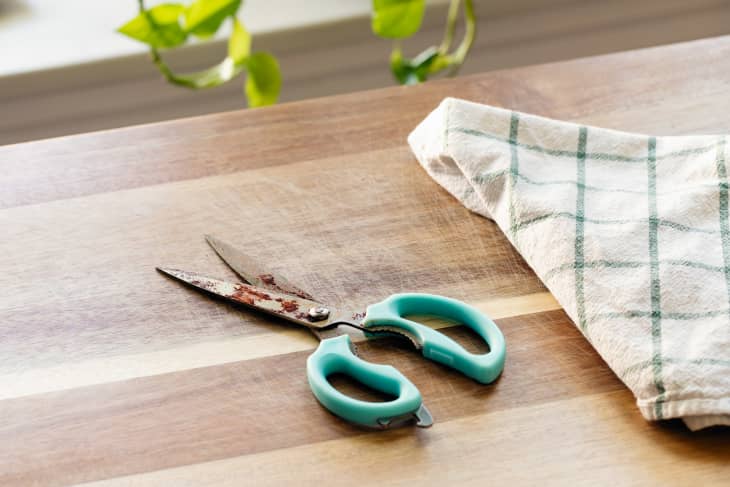4 Ways to Fix a Rusty Knife or Scissors
Allow us to be technical for a second, please. Rust — on your knives, scissors, or anywhere, really — is the end result of the oxidation of iron. Any metal that contains iron is prone to rust, including stainless steel. (Stainless steel is rust-resistant because it contains chromium. When the chromium is exposed to oxygen, a layer of chromium oxide forms on the surface of the blade, protecting it from rust. When this layer is damaged, however, rust can occur.) Rust formation is not an indication of the quality of your tools; although, if left untreated, it could affect their performance.
Rust forms in the presence of iron, moisture, and oxygen, all three of which are perpetually present in your kitchen. It’s no surprise, then, that from time to time, rust happens. Here are some food-safe ways to address rust on your kitchen knives and scissors, as well as a few tips for how to prevent it in the first place.
1. With a potato
Yes, a potato could be the answer to your rust problem. The oxalic acid found in potatoes is the “magic ingredient.” To use this method, place the blade of your knife in a whole potato and leave it there for eight to 10 hours. Remove the blade and the rust should be easy to wipe or scrub away. (Scrub it with the cut side of a potato for a double-punch of efficiency!) Wash and dry thoroughly.
2. With a lemon
Lemon juice also helps remove rust because of its acidity. Fill a glass or shallow bowl with lemon juice and place the knife or scissors in the juice. Leave for 10 to 15 minutes (or longer if the rust problem is more severe) and then wipe or scrub the rust away. You can also use a halved lemon to treat rust on your knives or scissor blades. For some extra abrasive power, dip the lemon in salt first. Wash your rust-free blades and dry them thoroughly.
3. With a baking soda paste
To polish rust away, make a paste of baking soda and water and cover the affected area. Let the paste sit for an hour or so and then scrub away. Wash and dry completely.
4. Soak in white vinegar
White vinegar, which has so very many uses around the house, can also help remove rust. Soak affected knives or scissors in vinegar overnight. You can soak them in a shallow dish or a glass. Alternately, you can soak a rag or towel in white vinegar and wrap it around the blade of the knife. Repeat the vinegar soak if some rusty problem areas remain. Wash thoroughly and dry thoroughly.
How to Prevent Your Knives and Scissors from Getting Rusty
To keep your knives and scissors from getting rusty, keep the following practices in mind.
- Wash and dry your knives and scissors immediately after use: If you usually allow your hand-washed dishes to air dry, consider drying your knives and scissors by hand, too, in order to cut down on moisture.
- Don’t put knives in the dishwasher: Dishwashing chemicals can compromise the chromium oxide layer of stainless steel. In addition, dishwashers expose your tools to more moisture than they should have.
- Don’t leave things sitting in the sink: It’s tempting to place your chef’s knife in the sink and let it all sit there until the morning. But letting your knives soak in the sink can compromise your blades and eventually lead to rust. Similarly, don’t leave wet knives or scissors waiting for their next task on a cutting board. Wash and dry these tools each time they’re used. It might seem fussy, but it’s easier than cleaning rust!
